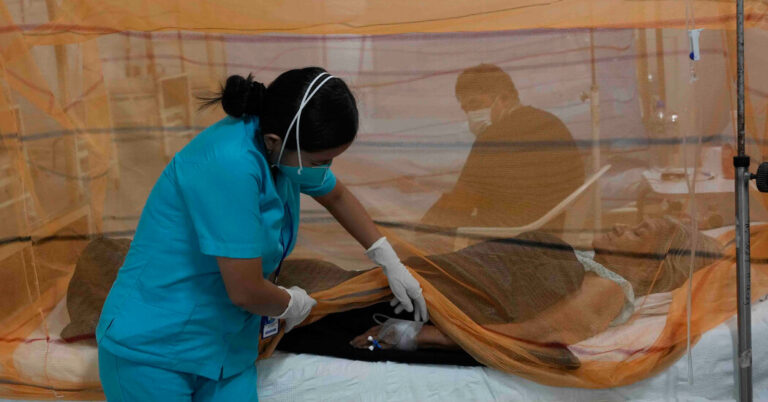The outbreak of dengue fever that has occurred in Latin America over the past three months has been staggering in its scale — a million cases in Brazil in a few weeks, a huge increase in Argentina, a state of emergency declared in Peru and now a yet in Puerto Rico.
This heralds a changing landscape for the disease. The mosquitoes that spread dengue thrive in densely populated cities with poor infrastructure, and in warmer, wetter environments — the kind of habitat that is expanding rapidly with climate change.
More than 3.5 million cases of dengue have been confirmed by governments in Latin America in the first three months of 2024, compared to 4.5 million in all of 2023. There have been more than 1,000 deaths so far this year. The Pan-American Health Organization warned that this could be the worst year for dengue on record.
The rapidly changing landscape of the disease calls for new solutions, and researchers in Brazil have delivered the only piece of good news in this story with the recent announcement that a clinical trial of a new dengue vaccine, given a single shot, had provided strong protection against disease.
There are two existing vaccines for dengue, but one is an expensive two-shot regimen, while the other can only be given to people who have already had a dengue infection.
The new one-shot vaccine uses live, weakened forms of all four strains of the dengue virus. It was created by scientists at the National Institutes of Health in the United States and licensed for development by the Instituto Butantan, a large public research institution in São Paulo.
Butantan will make the vaccine. It already produces most of the vaccinations used in Brazil, and has the capacity to produce tens of millions of doses of this new one. The institute plans to submit the dengue vaccine to Brazil’s regulatory agency for approval in the next few months and could begin production next year.
But that won’t help this outbreak and, by the time production begins and a national rollout begins, it may not be enough to help the next one, either; Dengue usually peaks in a three- or four-year cycle.
And it won’t necessarily help the rest of Latin America: Butantan will only make the vaccine for Brazil. The multinational drug company Merck & Co., which also licensed the NIH technology, is developing a related vaccine to be sold in other parts of the world; the efficacy of that vaccine has not yet been tested in a late-stage clinical trial.
And of course, there is a need for a dengue vaccine beyond the Americas: Mosquitoes are spreading the disease in Croatia, Italy, California and other regions where it has never been seen before. Areas that used to handle mild outbreaks are now facing record-breakers: Bangladesh had 300,000 cases last year.
Dengue is commonly known by the name breakbone fever, after the severe joint pain it causes. Not everyone gets sick: Three-quarters of people infected with dengue don’t have any symptoms, and of those who do, most cases resemble a mild flu.
But about 5 percent of people who get sick will progress to what’s called severe dengue. Plasma, the protein-rich liquid part of blood, can begin to leak into blood vessels, causing patients to go into shock or organ failure.
When patients with severe dengue are treated with blood transfusions and intravenous fluids, the mortality rate is between 2 and 5 percent. But when they don’t get treatment — because they don’t realize it’s dengue and don’t get treatment quickly enough, or because health centers are overwhelmed — the mortality rate is 15 percent.
In Brazil, the current dengue outbreak is hitting children the hardest; under-5s have the highest death rate of any age group, followed by ages 5 to 9. Young people between 10 and 14 have the highest number of confirmed cases, according to the Oswaldo Cruz Institutea national public health research center.
When clinics began to overflow with dengue patients in January, the Brazilian government bought the entire global stock of a Japanese-made vaccine for dengue called Qdenga. Public health nurses deliver it to children ages 6 to 16, but there will be enough vaccine to fully vaccinate only 3.3 million of Brazil’s 220 million people this year.
This huge national effort will protect several million children, but it will contribute nothing to its herd immunity.
Qdenga isn’t cheap: It’s about $115 per dose in Europe and $40 in Indonesia. Brazil pays $19 per dose, having negotiated a lower price for its bulk purchases.
Takeda Pharmaceuticals, which makes Qdenga, announced a deal last month with Biological E, a large Indian generic drug maker, to license and produce up to 50 million doses a year, part of a race to accelerate the production. The vaccine in India should be cheaper. But Biological E is unlikely to have regulatory approval to market it before 2030; it’s a slow process that involves transferring technology, setting up a production line and getting a new version of even a known product approved by regulators.
Dengue is costly in Brazil at least $1 billion a year in healthcare treatment and lost productivity. And that number doesn’t take into account the human suffering involved.
The fact that there are four different strains of the dengue virus further complicates the vaccine-making process: The potentially fatal form of the disease is more common when patients develop a second infection, with a different strain than the first. Qdenga protects against all four strains of dengue, and the hope is Butantan’s new vaccine, though data released so far show it has only been tested against the two strains circulating in the early stages. of testing; more results are expected in June.
Millions more people will be exposed to dengue once this outbreak is over. But they will need that new vaccine more urgently than ever.
